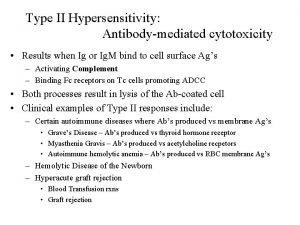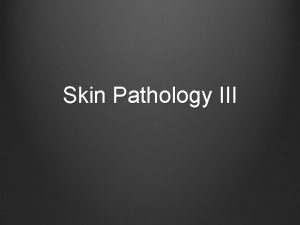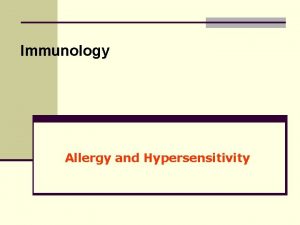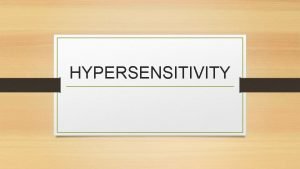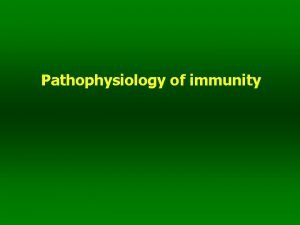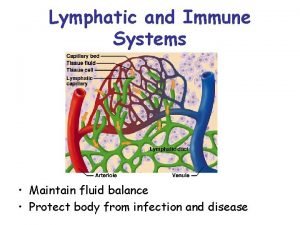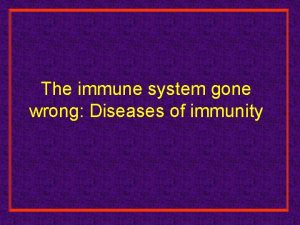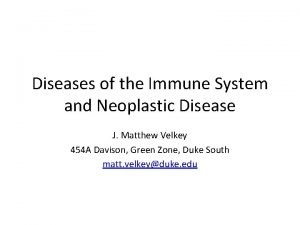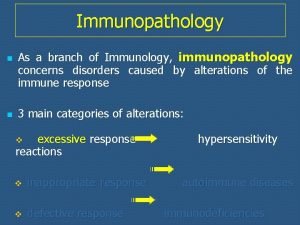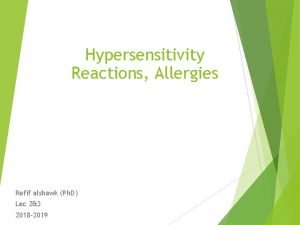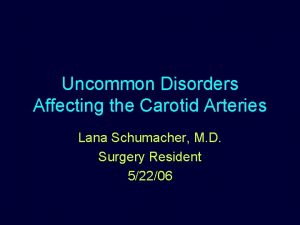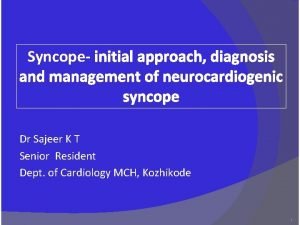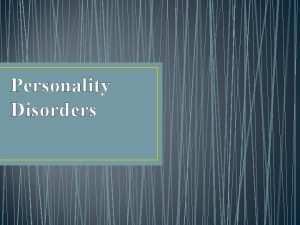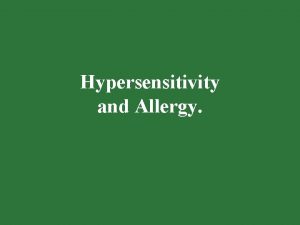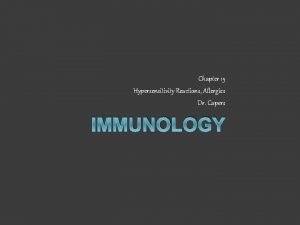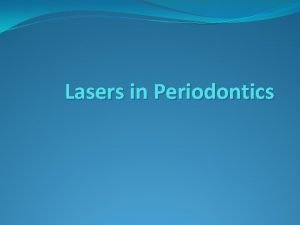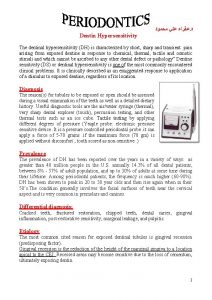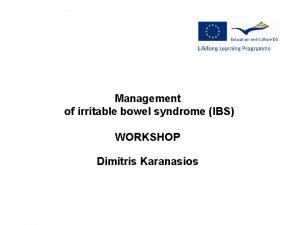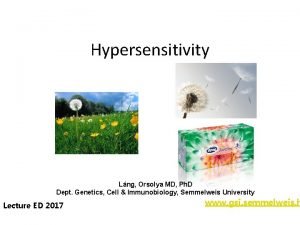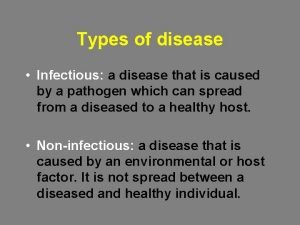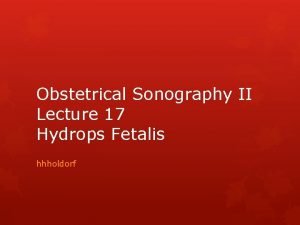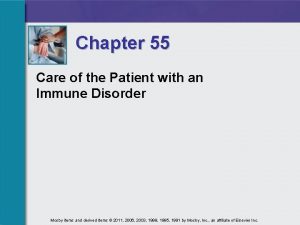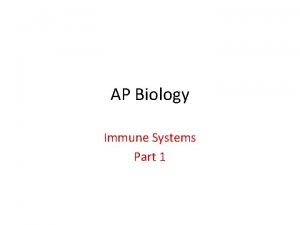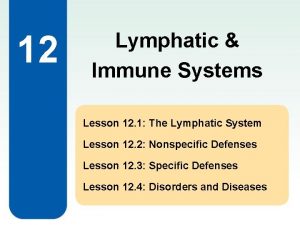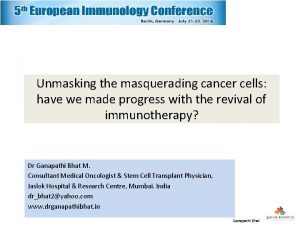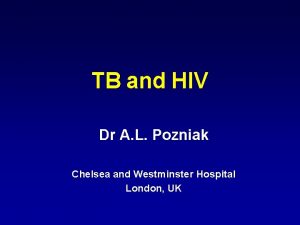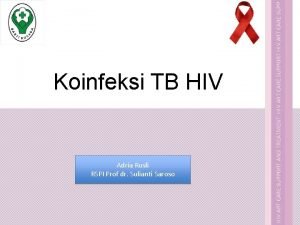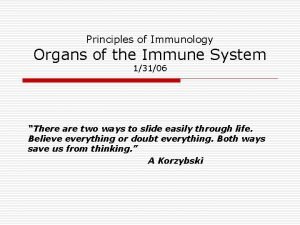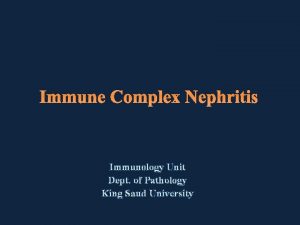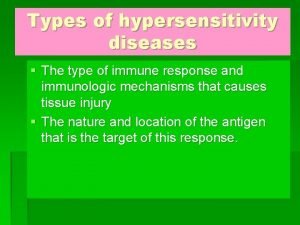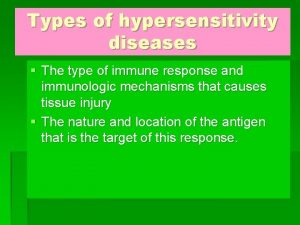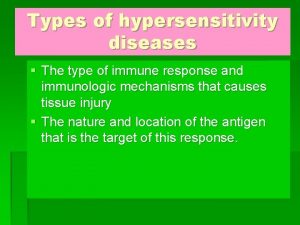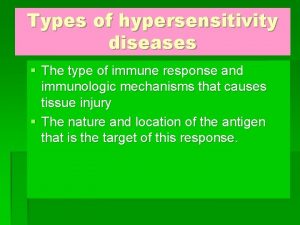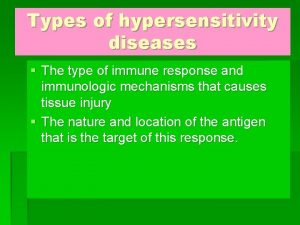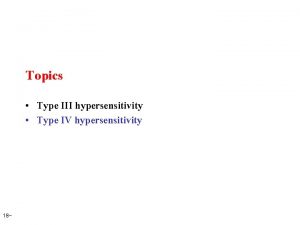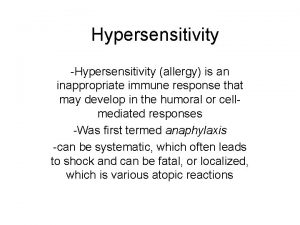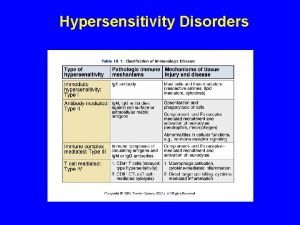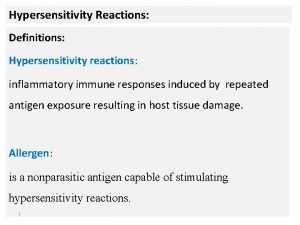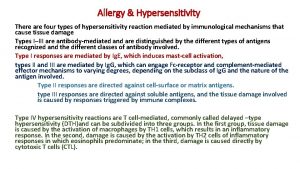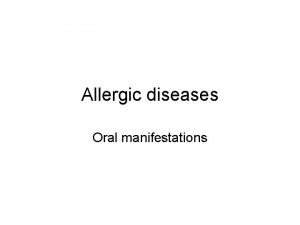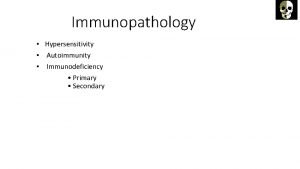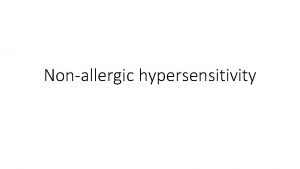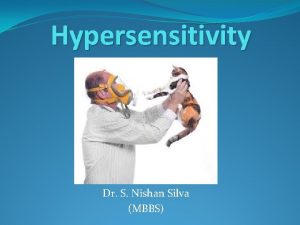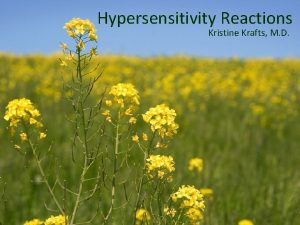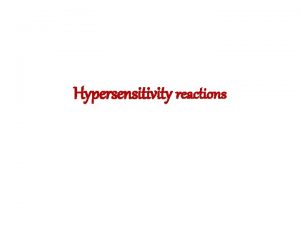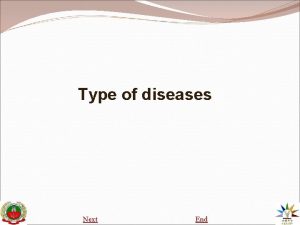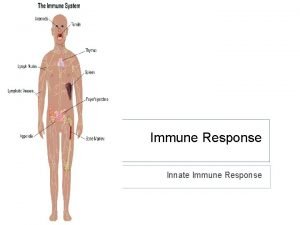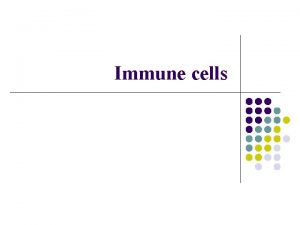Types of hypersensitivity diseases The type of immune









































- Slides: 41

Types of hypersensitivity diseases § The type of immune response and immunologic mechanisms that causes tissue injury § The nature and location of the antigen that is the target of this response.

Types of hypersensitivity diseases § Immediate H. S (Type I) caused by Ig. E § Type II H. S caused by antibodies other than Ig. E can cause tissue injury and interfering with normal cellular functions. § Type III H. S caused by deposition of circulating Immune complexes in tissues § Type IV or Delayed type hypersensitivity caused by T cells and Macrophages

Disease caused by Immune responses *Activation of Th 2 cells and production of Ig. E *Allergen Activation of Th 2 B cell activation Ig. E binding of Ig. E to Fc receptor reexposure to Allergen release of mediators pathologic reactions

General features (1)


General features(2) § There is a strong genetic predisposition for the development of immediate hypersensitivity *high level of Ig. E synthesis often run in families • Class –II MHC alleles • One locus for atopy is on chromosome 5, near the site of gene cluster encoding the IL-3, IL-4, • IL-5, IL-9, IL-13 and IL-4 R


Allergens § Type I is dependent on the activation of Th 2 cells § The clinical and pathologic manifestations of Type I: increased vascular permeability, vasodilation, smooth muscle contraction, local inflammation

Mast cell activation


Mast cell activation § Rapid release of granule contents(degranulation)such as Histamine, tryptase, chymase, proteoglyca ns(heparin and chondroitin sulfate) § Synthesis and secretion of lipid mediators(prostaglandines , Leukotrienes) § Synthesis and secretion of cytokines(IL 3, 4, 5, 6, TNF- )

Mediators actions § Histamine= bronchoconstrictor, vascular leak, intestinal hypermotility § PGD 2=vasodilator and bronchoconstrictor , neut. Chemotaxis § LTC 4=bronchoconstriction, inflammation § PAF=bronchoconstriction , vasodilator, inflammation

Clinical and pathologic features § § Hay fever(allergic rhinitis) Increased peristalsis Bronchial asthma Anaphylaxis

Wheal and Flare reaction

Skin test(PK test)

Therapy § § Inhibiting mast cell degranulation Antagonizing the effects of mediators Reducing inflammation Desensitization

Anti Ig. E as a therapy

§ Severe allergic reactions during anesthesia are fortunately rare, occurring only once in every 5, 000 to 25, 000 anesthetics. Unfortunately, these reactions can sometimes be fatal, with a 3. 4% mortality

§ Anaphylaxis during general (asleep) anesthesia presents in a similar way but there are three unique features: § First, the patient who is asleep cannot tell us about light-headedness or breathlessness § Second, during a typical general anesthetic, many drugs are given, and it is hardly ever clear which of these drugs have caused the reaction § Third, during anesthesia there are many other potential causes for the blood pressure to be

§ Treatment may include insertion of a breathing tube, administration of intravenous fluids, and a variety of drugs, the most important of which is epinephrine (adrenaline). Early and appropriate treatment is almost always successful. § drugs are not the only cause of allergic reactions, and a recently recognized cause of anaphylaxis is allergy to natural rubber (or `latex`). Reactions to latex are a special problem during anesthesia as surgical gloves are usually made of this material.

Food Allergy

Introduction to food allergies § When people have an unpleasant reaction to something they ate, they often think that they have an allergy to the food. Actually, however, only about 10 -15% of adults and children have clinically proven true allergic reactions to food. § This difference between the prevalence of clinically proven food allergy and the public's perception of the problem is due primarily to misinterpreting food intolerance or other adverse reactions to food as food allergy § A true food allergy is an abnormal response to food that is triggered by a specific reaction in the immune system and expressed by certain, often characteristic, symptoms. § People who have food allergies must identify and prevent them because, although usually mild and not severe, these reactions can cause devastating illness and, in rare instances, can be fatal.

§ § § food intolerance Food allergy food poisoning

§ Histamine toxicity: Some natural substances (for example, histamine) in foods can cause reactions resembling allergy. Histamine can reach high levels in cheese, some wines, and certain fish, particularly tuna and mackerel. § Food additives: Another type of food intolerance is an adverse reaction to certain compounds that are added to food to enhance taste, provide color, or protect against the growth of microorganisms. § The compounds most frequently tied to adverse reactions that can be confused with food allergy are : § yellow dye number 5 § monosodium glutamate (MSG) § and sulfites.

The allergens in food § § Resist the heat of cooking The acid in the stomach The intestinal digestive enzymes. The allergens survive to cross the gastrointestinal lining § enter the bloodstream,

What are the most common food allergies? § In adults, the most common foods that cause allergic reactions are shellfish, such as shrimp, crayfish, lobster, and crab; nuts from trees, such as walnuts; fish; eggs; and peanuts. § In children, the pattern is somewhat different from adults, and the most common foods that cause allergic reactions are eggs, milk, peanuts, and fruits, particularly tomatoes and strawberries.

What is cross-reactivity? § Cross-reactivity is the occurrence of allergic reactions to foods that are chemically or otherwise related to foods known to cause allergy in an individual.

What are the symptoms and signs of food allergy? § All of the symptoms of food allergy occur within a few minutes to an hour of eating. § A food allergy can initially be experienced as an itching in the mouth and difficulty swallowing and breathing. § Then, during digestion of the food in the stomach and intestines, symptoms such as nausea, vomiting, diarrhea, and abdominal pain can start. § Incidentally, the gastrointestinal symptoms of food allergy are those that are most often confused with the symptoms of different types of food intolerance. § the allergens are absorbed and enter the bloodstream. When they reach the skin, allergens can induce hives or eczema, and when they reach the airways, they can cause asthma. § As the allergens travel through the blood vessels, they can cause lightheadedness, weakness, and anaphylaxis, which is a sudden drop in blood pressure.

§ What was the timing of the reaction? Did the reaction come on quickly, usually within an hour after eating the food? § Was treatment for allergy successful? For example, if hives stem from a food allergy, antihistamines should relieve them. § Is the reaction always associated with a certain food? § Did anyone else get sick? For example, if the person has eaten fish contaminated with histamine, everyone who ate the fish should be sick. In an allergic reaction, however, only the person allergic to the fish becomes ill. § How much did the patient eat before experiencing a reaction? The severity of the patient's reaction can sometimes relate to the amount of the suspect food eaten. § How was the food prepared? Some people will have a violent allergic reaction only to raw or undercooked fish. A thorough cooking of the fish destroys those allergens in the fish to which they react, so that they then can eat it with no allergic reaction. § Were other foods eaten at the same time as the food that caused the allergic reaction? Fatty foods can delay digestion and thus delay the onset of the allergic reaction.


§ § § Cromolyn sodium Theophyllin blocks phosphodiesterase epinephrin

How is food allergy diagnosed? § § § History Elimination diet Skin tests Blood tests Food challenge

§ scratch test to test a number of potential allergens at one time Inexpensive less sensitive The size of the hive may correlate with the intensity of the allergic reaction. In the event of a severe reaction, the allergist will administer a rescue medication such as epinephrine or an antihistamine necessary to remove the patient from an anthihistamine medication regimen

§ RAST test or radioallergosorbent § expensive § considered as accurate as food challenges § they are considered a very safe way to test for food allergies § less sensitive than skin prick tests § a positive RAST test will be often be confirmed with a food challenge

§ RIST(radiolabeled Immunosorbent test)

§ The suspected allergen is bound to an insoluble material and the patient's serum is added. If the serum contains antibodies to the allergen, those antibodies will bind to the allergen. Radiolabeled anti-human Ig. E antibody is added where it binds to those Ig. E antibodies already bound to the insoluble material. The unbound anti-human Ig. E antibodies are washed away. The amount of radioactivity is proportional to the serum Ig. E for the allergen. § RAST are often used to test for allergies when: • a physician advises against the discontinuation of medications that can interfere with test results or cause medical complications; • a patient suffers from severe skin conditions such as widespread eczema or psoriasis; or • a patient has such a high sensitivity level to suspected allergens that any administration of those allergens might result in potentially serious side effects.





 Primary immune response and secondary immune response
Primary immune response and secondary immune response Examples of type 2 hypersensitivity
Examples of type 2 hypersensitivity Pemphigus vulgaris type 2 hypersensitivity
Pemphigus vulgaris type 2 hypersensitivity Serum sickness hypersensitivity type
Serum sickness hypersensitivity type Defination of hypersensitivity
Defination of hypersensitivity Dermatomyositis hypersensitivity type
Dermatomyositis hypersensitivity type Type 2 hypersensitivity
Type 2 hypersensitivity Hygiene hypothesis
Hygiene hypothesis Delayed type hypersensitivity reactions
Delayed type hypersensitivity reactions Anaphylaxis images
Anaphylaxis images Types of allergic reactions
Types of allergic reactions Define immunity
Define immunity Carotid sinus hypersensitivity
Carotid sinus hypersensitivity Complications of local anesthesia in dentistry
Complications of local anesthesia in dentistry Hypersensitivity personality
Hypersensitivity personality Hypersensitivity
Hypersensitivity Sensitization hypersensitivity
Sensitization hypersensitivity Gingivectomy
Gingivectomy Dental hypersensitivity
Dental hypersensitivity Visceral hypersensitivity
Visceral hypersensitivity Anaphylactoid vs anaphylaxis
Anaphylactoid vs anaphylaxis Hypersensitivity definition
Hypersensitivity definition Type of disease
Type of disease What is the third line of defense in the immune system
What is the third line of defense in the immune system Flow chart of wbc
Flow chart of wbc Third line of defense immune system
Third line of defense immune system Hydrops fetalis
Hydrops fetalis Difference between innate and learned behavior
Difference between innate and learned behavior Innate immunity first line of defense
Innate immunity first line of defense Chapter 35 immune system and disease
Chapter 35 immune system and disease Chapter 55 care of the patient with an immune disorder
Chapter 55 care of the patient with an immune disorder 1st 2nd and 3rd line of defense immune system
1st 2nd and 3rd line of defense immune system Ap biology immune system
Ap biology immune system Chapter 24 the immune and lymphatic systems and cancer
Chapter 24 the immune and lymphatic systems and cancer Lesson 12 blood and immune system
Lesson 12 blood and immune system Lesson 12 blood and immune system
Lesson 12 blood and immune system Immune checkpoint inhibitors mechanism of action
Immune checkpoint inhibitors mechanism of action Immune reconstitution inflammatory syndrome
Immune reconstitution inflammatory syndrome Dr adria rusli
Dr adria rusli Oobean
Oobean Immunity definition
Immunity definition Immune complex glomerulonephritis
Immune complex glomerulonephritis

